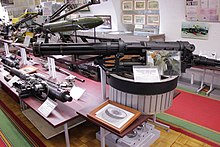Gryazev-Shipunov GSh-6-23
The Gryazev-Shipunov GSh-6-23 (Russian: Грязев-Шипунов ГШ-6-23) (GRAU designation: 9A-620 for GSh-6-23, 9A-768 for GSh-6-23M modernized variant) is a six-barreled 23 mm rotary cannon used by some modern Soviet/Russian military aircraft.[4]
| Gryazev-Shipunov GSh-6-23 | |
|---|---|
 GSh-6-23M on the installation of 9-EYU-768K, designed to equip the MiG-31 interceptor | |
| Type | Rotary cannon |
| Place of origin | Soviet Union |
| Service history | |
| In service | 1975-present |
| Production history | |
| Designer | Vassily P. Gryazev and Arkady G. Shipunov |
| Manufacturer | KBP Instrument Design Bureau Tula |
| Specifications | |
| Mass | 73–76 kg (161–167 lb) |
| Length | 1.4 m (4 ft 7 in) |
| Height | 18 cm (7 in) |
| Cartridge | 23×115mm AM-23 |
| Caliber | 23 mm |
| Barrels | 6 |
| Action | Gas-operated |
| Rate of fire | 6,000–8,000 (standard).[1] 9,000–10,000 rpm (alleged maximum) [2][3]. |
| Muzzle velocity | 715 m/s (2345 ft/s) |
| Feed system | Belt or linkless feed system |
The GSh-6-23 differs from most American multi-barreled aircraft cannon in that it is gas-operated, rather than externally powered via an electric, hydraulic, or pneumatic system.
.jpg)
The GSh-6-23 uses the 23×115 Russian AM-23 round, fed via linked cartridge belt or a linkless feed system.[5] The linkless system, adopted after numerous problems and failures with the belt feed, is limited.[6] Fire control is electrical, using a 27 V DC system. The cannon has 10 pyrotechnic cocking charges, similar to those used in European gas-operated revolver cannon such as the DEFA 554 or Mauser BK-27.
The rapid rate of fire exhausts ammunition quickly: the Mikoyan MiG-31 aircraft, for example, with 260 rounds of ammunition (800 rounds maximum), would empty its ammunition tank in less than two seconds.
GSh-6-23M has the highest rate of fire out of any autocannon so far.[7]
The GSh-6-23 is used by the Sukhoi Su-24 attack aircraft, the MiG-31 interceptor aircraft, and the now-obsolete Sukhoi Su-15 among others. However, after two Su-24s were lost because of premature shell detonation in 1983, and because of some other problems with gun usage (such as system failures), usage of the GSh-6-23 was stopped by a decision of the Soviet Air Force Command. At present all aircraft in the Russian Air Force are flying with fully operational guns.[8]
It is also used in the SPPU-6 gun pod, which can traverse to −45° elevation, and ±45° azimuth.[9]
Variants
- Gryazev-Shipunov GSh-6-23M; a modernized version.
See also
- GAU-8 Avenger
- Gryazev-Shipunov GSh-23
- Gryazev-Shipunov GSh-6-30
- M61 Vulcan
- M134 Minigun
- List of Russian weaponry
References
- Gordon, Komissarov, Yefim, Dmitriy (30 October 2011). Flight Craft 8: Mikoyan MiG-31: Defender of the Homeland. Google Books. ISBN 9781473869202.
- Fillipov, Alexei. "Nobody Does It Better: Russian Aircraft Cannons Outgun America's". Sputnik International.
- Skaarup, Harold (May 2008). Canadian MiG Flights. Google Books. ISBN 9780595520718.
- Gordon, Yefim; Komissarov, Dmitriy (30 October 2011). Flight Craft 8: Mikoyan MiG-31: Defender of the Homeland. ISBN 9781473869202.
- "From 20mm to 25mm - The Russian Ammunition Page". Retrieved 26 November 2014.
- "Untitled Document". Retrieved 26 November 2014.
- "GSh-6-23M".
- "Untitled Document". Retrieved 26 November 2014.
- http://weaponsystems.net/weaponsystem/HH13%20-%20SPPU-6.html
Sources
- Rapid Fire, Anthony G. Williams, Airlife UK, August 2000
- Koll, Christian (2009). Soviet Cannon - A Comprehensive Study of Soviet Arms and Ammunition in Calibres 12.7mm to 57mm. Austria: Koll. p. 162. ISBN 978-3-200-01445-9.